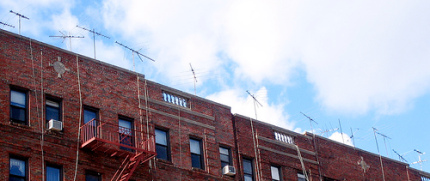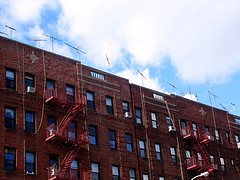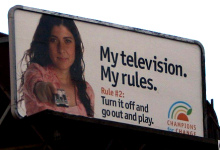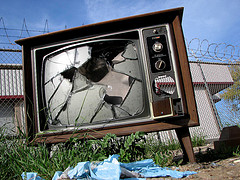
One year from now, a New Yorker's television will suddenly stop working. More likely, a great many New Yorkers' televisions will stop working. It's hard to say who they will be, but they will probably think they are alone. They are likely to be older residents, with limited formal education, living on low fixed incomes, who do not speak English. Some will be residents of cavernous blocks, on lower floors in the shadow of a large building or behind a thick tree cover. We don't know who they will be, but some of the hundreds of thousands of New Yorkers who get free television over the airwaves will lose their signal.
Though many New Yorkers don't yet know it, the clock is ticking on their television reception. The federal government has set Feb. 17, 2009, as the date on which television broadcasters must switch from an analog signal to a digital one. This change means anyone with a television set more than a couple of years old who wants to keep getting free broadcasts over the air needs to take action.
The transition to digital television, which was mandated by Congress in 2005, will free up portions of the airwaves for new uses (digital transmission uses narrower slices of the spectrum than analog) and enhance data services like closed captioning. Viewers who make a smooth transition to digital television (DTV) should see more channels with clearer reception.
To make a smooth transition, however, any television set that relies on analog signals will need a converter installed between the set and the antenna. Using money from the sale of portions of the newly freed up airwaves, Congress has set aside $1.5 billion to subsidize the purchase of digital converters with coupons that will make the cheapest converters nearly free. Converter coupons won't be enough to keep everyone's television working, however.
Two recent, independent reports suggest that the government-mandated transition process will leave many viewers without a signal. The reports suggest that there are many places where this transition could go wrong. While they lay the blame on the government, at this point individual consumers need to take action.
Weak Signals
To get converters, though, consumers have to know they need them. Many, though, don't know that the transition is coming. For all of the money the government is spending on coupons, they plan to spend just $27.5 million on public education. The United Kingdom, by contrast, has budgeted $400 million to inform a population one-fifth the size. "The federal government is relying very heavily on industry to educate consumers and that's resulting in a large amount of confusion over what consumers should do to prepare," says Joel Kelsey, Grassroots Coordinator for Consumers Union. Consumers Union's publication Consumer Reports recently launched a comprehensive guide to the transition.
If you have seen a public service announcement about the digital television transition, it was probably sponsored by the DTV Transition Coalition, a consortium of cable, broadcast and consumer electronics industry groups. The industry-sponsored effort, valued at $697 million, does not explain all of the issues though.
Nielsen Data assessed by Consumer Reports ranked the New York City metropolitan area sixth in the country in terms of sheer number of households currently getting their only television signal free over the airwaves: Almost 357,000 New York City households depend entirely on over-the-air television signals. Though these households comprise less than 5 percent of those that own televisions in the city -- much lower than the national average of 15 percent -- they are overwhelmingly low income, elderly and isolated: They are both vulnerable and hard to reach.
Among the issues not being fully addressed: what happens to cable or satellite subscribers whose service goes out or gets shut off? Consumers Union found in their polling that many pay television consumers indicated they would be very concerned if they were unable to receive an over the air signal during an emergency. If a storm knocks out cable service in your neighborhood, anyone with only an analog television will be left without a signal until the cable company repairs the lines. Households that might be thinking of cutting the expense of cable out of already tight budgets won't be able to turn off their service and still watch the news if they don't get a converter.
Even if every American television viewer gets the message and acquires and installs a converter, some will still have technical difficulties. "It's a systems issue," says Barry Goodstadt, senior vice president of research for Centris, which conducts independent telecommunications research and recently released a report on gaps in digital television coverage. Centris found as many as 580,000 households in our region that stand to be affected by the transition, homes that have and use multiple televisions, some of which rely on the airwaves for their signal. Moreover, as Centris points out, the converter box is just one piece of the puzzle. "The problem," Goodstadt says, "is that the converter box is only as good as the antenna it's hooked up to."
Straight Signals

Unlike analog signals, which can bounce down different paths to your TV or fade out over long distances, digital signals don't go static; either you see it or you don't. Traditional television-top "rabbit ears" may not be able to pick up the digital signal. Centris' phone surveys found that nearly 80 percent of Americans who receive their television signal free over the airwaves have only set-top antennas. This could create large gaps in digital television signals' reach, though it remains hard to know how many households will be affected. Centris will be conducting surveys and tests in New York and other cities over the next two months. The Federal Communications Commission and industry groups have disputed Centris' conclusions, offering somewhat rosier alternative assessments.
No matter who you believe, some households will need both a converter box and to upgrade from rabbit ears to a rooftop antenna. In some cases, existing rooftop antennas will need upgrades. Installing or upgrading a rooftop antenna means running electricity and coaxial cable to the roof. However, as the Centris team points out, the public education campaigns do not even mention the word "antenna."

"That is why we brought this stuff up," says Goodstadt. "We don't want consumers to have a horrible experience going through this transition. And if we ignore the antenna issue, some people will. There are some costs and issues that the government simply is not recognizing."
Potential for Abuse
If the process is bungled, it could turn into a boon for cable and satellite providers as long-time holdouts give up trying to tune in free TV. Anyone who sells or installs antennas or converter boxes should also fare well. But whether households switch to cable, upgrade antennas, replace their television sets, or acquire converter boxes, the money for all of these solutions is ultimately going to come from the consumer. As Kelsey puts it, "Consumers who didn't ask for a switch to digital television are now being required to spend a huge amount of money on a box and an antenna to watch free TV broadcast over public airwaves."
A situation where people know they need to spend money, but not exactly on what, is ripe for fraud. New Yorkers who don't speak English may miss most advertisements, and those who are afraid to interact with the government will not be able to claim their converter box coupons. An unscrupulous landlord could also acquire the coupons for all of his tenants and then sell the cards or use them to buy converters to sell. Cable subscribers who don't need a converter, could do the same thing.
Added Costs
One potential cost will be to the environment. A Consumers Union survey found that nearly a quarter of consumers who are aware of the transition believe they will need to throw out their analog televisions after 2009. "This would mean thousands of perfectly good televisions getting kicked to the curb," Kelsey worries, "resulting in an immense amount of dangerous electronic waste" -- something New York City already has enough of.
There is another option: one survey conducted by the cable industry in November found that many households plan to keep their obsolete televisions for DVD watching or to give up television entirely.
Are NYC Broadcasters Ready?

The final link in the DTV transition chain is the broadcasters themselves. Some smaller broadcasters are asking the FCC for a waiver that will allow them to shut off analog broadcasts before the deadline, which would mean that viewers without a digital setup would lose those channels early. Smaller, low-power TV stations do not have to meet the deadline and may not have a digital signal come next February; viewers will lose those channels unless they have a "pass through" converter box that can handle both kinds of signals.
New York's major broadcasters are already transmitting digital signals and will continue analog broadcasts until the cutoff, but some have complicated plans to switch channels over the course of a couple of days or even minutes.
"We're ready to go," said one engineer at WNYW, the local Fox affiliate that broadcasts from the top of the Empire State Building. Though he's certainly the station's expert on this topic, he's not an official company spokesperson so he asked to remain anonymous. He thinks some of the city's stations are further along in their preparations than others, but "by the time we get to February '09, New Yorkers will be alright."
The WNYW engineer and his colleagues have been from midtown to Long Island testing reception. He's found newer digital TVs to be much better at picking up a signal than the first generation of digital TVs that are three or four years old now, but he sees the transition as a government-mandated process of trial and error. He's concerned that the regulators and politicians won't respond quickly to the feedback from the engineers. No amount of preparation or technological enhancement can ensure that no New Yorkers lose their signal and do not know what to do about it.
So, What Are You Waiting For?
Goodstadt and Kelsey both offer the same advice to New Yorkers who are concerned that they might lose their television signal: Don't wait. Get your coupons, get your converter box, set it up, and see if it works.
Joshua Breitbart is policy director for People's Production House.
Â




